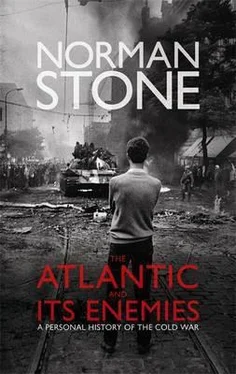There would in ordinary circumstances have been something of a problem with foreign exchange. If governments produced paper money in excess of other governments’ production of it, then the rate of exchange between the virtuous currency and the vicious one would clearly be affected. Why should Germans, their money prudently run by the Bundesbank, have to exchange their solid Mark at twelve to the dollar? The answer lay in the post-war system loosely (and not altogether accurately) known as Bretton Woods. The dollar was the anchor currency, taking most of the role of the British pound in its imperial days, and it had a fixed value in terms of gold: if foreigners wanted to exchange their dollars for gold, they were (in theory) free to do so, and the Americans, at Fort Knox, had laid up an enormous treasure of it. The fixed dollar had been associated not just with the fifties trade boom, but with the recovery of western Europe; the system therefore seemed sacrosanct, the more so as the American military undertook the burden of defence in western Europe.
With Kennedy, there was the first small step towards the weakening of this structure. He began the debauching of the dollar — what would have been called coin-clipping in earlier times, as rulers surreptitiously reduced the amount of silver in their coins (the milled edge around some modern ones is a survival from that era, showing that the coins had not been clipped). Quite outside the economists’ advice, there was temptation towards this course, because the dollar was in such a strong position that the USA could in effect just pay its foreign bills by printing pieces of paper. There was a minor recession in 1958-9 and the government’s finances were dented. A deficit appeared. Kennedy did not reduce spending, and reduced taxes that were still remarkably high, because of post-war responsibilities and the level of arms-spending. The pound sterling was by now being moved closely in concert with the dollar. They were the world’s trading currencies, and in the past the pound had been a true anchor. It could be exchanged, on demand, for gold, and the world’s prices had on the whole been stable while the gold standard was in force. Now, the pound followed the dollar, and in 1958 the Macmillan government also took an unorthodox financial course, of spending when there was no money to back it. Three Treasury ministers resigned in protest, and this was dismissed by Macmillan as ‘a little local difficulty’. It was, but it was a sign of great crises to come. By 1971 the post-war economic order, the very underpinning of fifties prosperity, was in disarray.
Even in 1960 the dollar was the victim of its own success. The real problem was to get the Americans to let the dollar be used as the world’s currency. That meant the printing of dollars for world (especially European) purposes. If any country bought more abroad — mainly of course in the USA — than it sold, its currency might become weak, and an International Monetary Fund came into existence, mainly with American contributions, to lend that country money to tide it over while it managed its affairs better, and sold more. The classic case of that was Germany, though the money came not from the International Monetary Fund but from other sources such as the Marshall Plan or the European Payments Union. There was also, from Bretton Woods, a World Bank (‘International Bank for Reconstruction and Development’) with, at the time, very limited resources. These institutions were meant to encourage world trade, made a brave start, encountered the Cold War and the troubles of western Europe, and stalled. Under the European Payments Union, a more limited system did emerge, and trade between the recovering (or booming) European countries was greatly promoted by it. If any country was in deficit on trade, its currency was supported by the country with the surplus. That way, the weaker country could go on buying. That system worked in the 1950s only in Europe. At the time, European currencies were still weak, and there was very limited credit; neither Frankfurt, the German financial capital, nor Paris had well-developed financial institutions such as a stock exchange, and in Germany most firms notoriously raised their own money from a bank or even from family savings. The system was closed to the dollar, as the European currencies could not be converted into dollars without enormous bureaucratic involvement. However, as trade grew, and as European prosperity rose, these restrictions came under pressure. In the first place, the Americans, using paper dollars, invested in Europe — in 1956 private dollars more than government ones. Conversion was therefore much easier for Europeans, especially Germans. But there were also easy ways round the restrictions: false invoicing, for instance, by which buyers and sellers agreed as to the recording of a figure for a purchase that was not true, the hidden balance then transferred, in dollars or Swiss francs, to some bank outside the system, in Switzerland for preference, though Luxemburg also made itself useful.
The Germans had been exporting successfully to the USA — their surplus on trade in 1958 amounted to $6bn — and had collected dollars. But dollars also went from the USA to Germany (and other European countries) because of the profits that investors could make there — greater than in the USA. There was a further problem. Some very large American firms established themselves overseas, partly to take advantage of cheaper labour costs, and partly to get over protectionist barriers. In France, especially, a desire to build up native industries meant that foreign goods were kept out. It was obvious, in that case, for the first of the great American electronic-computer firms, IBM or Xerox, to set up factories in France and elsewhere. These firms also represented a dollar outflow to Europe. The result was that in Europe there were large sums of money in dollars, the ‘eurodollar’.
In theory these dollars could be exchanged for gold, at $32 per ounce, and efforts were made to control the gold market somehow. If these dollars were at any stage sent back to the USA, with a demand for them to be exchanged into gold at the fixed rate, it might go beyond what the USA could stand. This eventually happened in summer 1971, and it was the end of the extraordinary quarter-century of prosperity that had followed the Marshall Plan of 1947. To stop this meant the Americans’ keeping their own government spending in reasonable bounds, and it also meant international co-operation: the European banks would have to buy up the spare dollars. A Belgian economist, Robert Triffin, who had migrated to Yale, had foreseen this problem — the Americans, required to send dollars abroad, would lose control of their own currency, and it could then slide in value. By 1960 eurodollars were already greater in value than the gold held in reserve at Fort Knox. With the British pound, which still accounted for half of the world’s trade, the problem was much greater, given the weakness of the British economy and the extent of British overseas commitments, with garrisons ‘east of Suez’ to keep some kind of control over the petrol reserves, or, for instance, to deter the Indonesians from invading Malaysian territory. As Europe recovered in the 1950s, these problems were under control, but by 1958 there was a deficit in the American balance of payments — $5bn — and $2bn went abroad in foreign investment.
American business was still enormously successful and the great firms — Ford, which was all over the place, but many others — were all doing well, setting up overseas. The eurodollar problem was still easily under control, and the problem would have gone away altogether if a dollar devaluation had been allowed, or some revaluation of the Mark, which was anyway very low. The German exporters themselves did not want such a revaluation, because they thought that, if their prices rose, they would lose customers; and in any case holders of eurodollars did not want their value to be reduced. Instead of a serious readjustment, various hand-to-mouth expedients were used. The International Monetary Fund’s resources were too low to be very useful — they were still, in 1958, at the same level as ten years before, despite the huge increase in trade. Instead, a group of trading industrial countries was set up, the G10, in 1960. This happened just when, for the first time, people sold their dollars for German Marks. Gold on the free market also rose above $32 per ounce. This did not worry Kennedy. In his first year, a decision was taken to increase spending, and to take on a deficit. It was the first point at which post-war financial management broke with old prudent ways. Not many people objected, at the time. As a leading expert, Barry Eichengreen, comments, it was all rather clumsily done, yesterday’s problems being solved by the creation of tomorrow’s. He adds, ‘the array of devices to which the Kennedy and Johnson administrations resorted became positively embarrassing. They acknowledged the severity of the dollar problem while displaying a willingness to address only the symptoms.’ Americans were not allowed to own gold coins; visas became easier to encourage tourism, the virtues of Disneyland advertised. Besides, the low official price of gold, and the difficulties set up about using it, discouraged output and so made the potential problem worse. In the USA inflation in the sixties ran to 30 per cent, the very problem that Keynes’s critics had identified.
Читать дальше












![Edward Ellis - Adrift on the Pacific - A Boys [sic] Story of the Sea and its Perils](/books/753342/edward-ellis-adrift-on-the-pacific-a-boys-sic-s-thumb.webp)